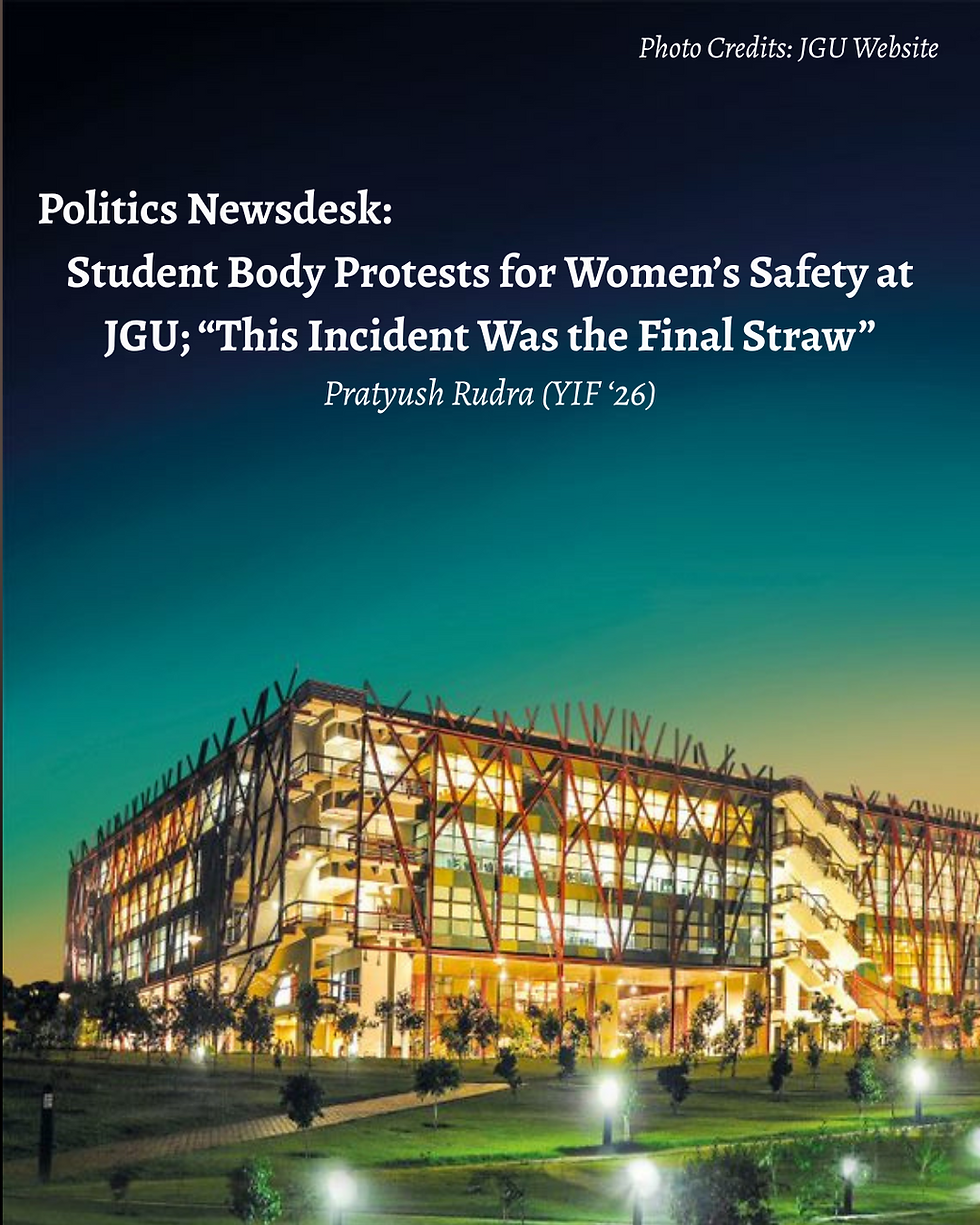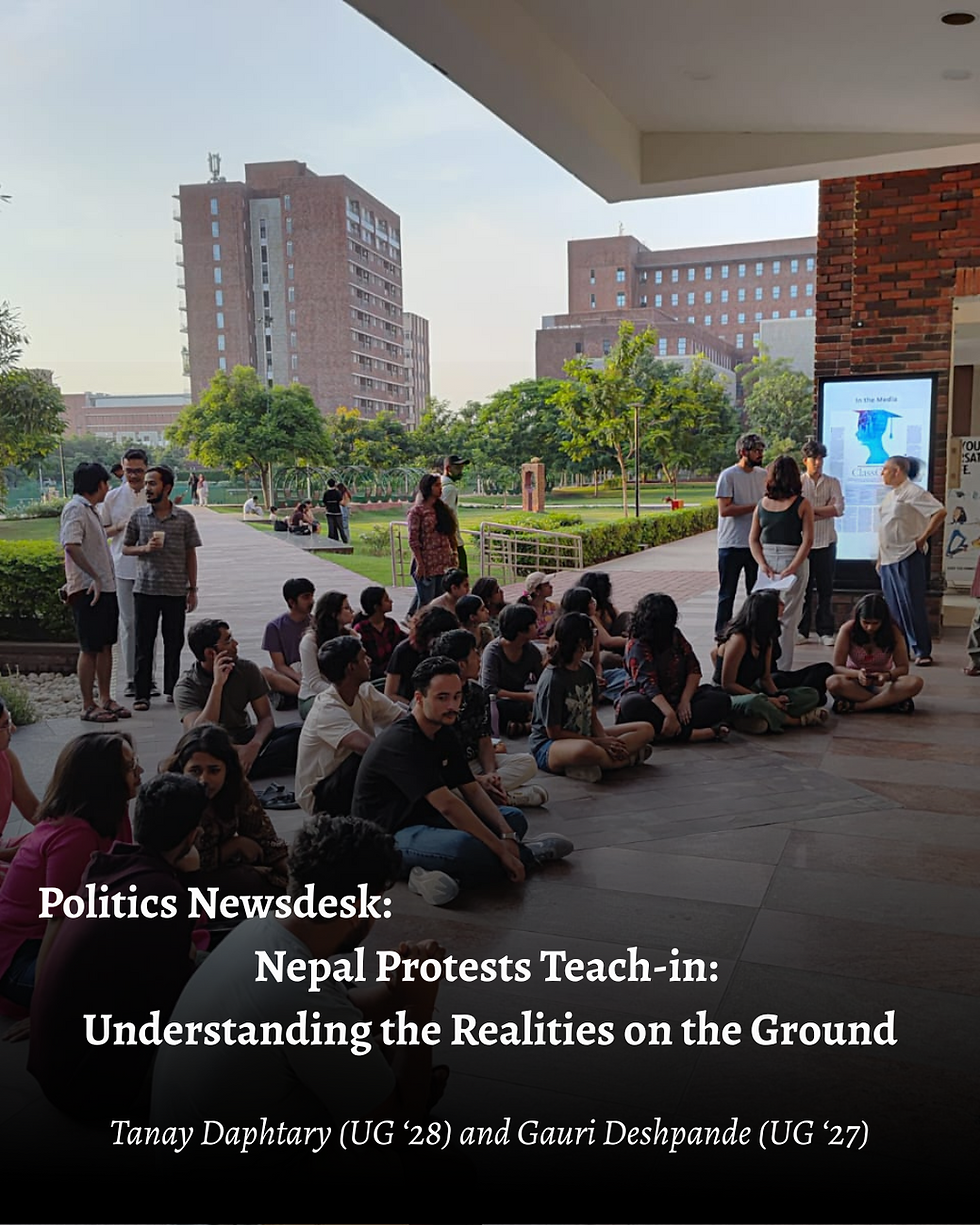The Politics of Repression
- Mehnoor Nisar
- Oct 28
- 5 min read
When governments choose to treat their youth as expendable, they unwittingly create the opposition they fear the most. In Sri Lanka, it was the young protestors who camped outside the president’s office for months, forcing a government to resign. In Pakistan, the decades-old ban on student unions is being challenged, breathing new life into the country’s political discourse. Over the past decade, a pattern has emerged across South Asia: policies and practices that shut youth out of economic opportunity and political voice have led an entire generation to rethink what political participation and belonging mean. From the student hostels of Dhaka to the high-altitude valleys of Leh and the bustling plazas of Kathmandu, young masses have become the architects of a hybrid, adaptive, and deeply moral politics that state machinery, in its most inventive forms, cannot contain.
In Bangladesh, the restoration of a job-quota system in 2024 reserving thirty percent of government positions for descendants of freedom fighters was presented as a gesture of national homage. However, beneath this rhetoric, the policy was systematically hijacked by the Awami League to reward political allegiance and entrench its bureaucratic control. Graduates who had spent years earning degrees found themselves on the wrong side of a patronage game, where family connections and favoritism determined careers. When students dared to demand fair recruitment practices, security forces responded with systematic violence. The United Nations Human Rights Office reports later estimated that up to 1,400 people were killed in the six-week uprising. It was a brutality that only confirmed what protesters had been saying all along: the state values control over accountability.
In India’s Union Territory of Ladakh, the story was different in form but the same in essence. The 2019 revocation of Articles 370 and 35A stripped away constitutional safeguards that had recognised the region’s unique political, cultural and ecological needs. Young Ladakhis watched as decisions about their future were taken hundreds of miles away in New Delhi, without consultation or consent. They then took to the streets in September 2025, demanded statehood and inclusion under the Sixth Schedule of the Constitution, asked for a local public service commission, and more seats in the parliament. It escalated into violent confrontations leading to the killingsof four individuals, and dozens were injured. Instead of listening, the authorities imposed curfews across the region and shut down mobile internet. They went further by revoking NGO licenses and arresting the widely-respected activist Sonam Wangchuk. These measures were meant to snuff out dissent. Instead, they shed light on the struggle's stakes. For Ladakh’s youth, this is not merely about political power. They need to preserve delicate terrain that sustains them and ensure that their voices could shape the future of the mountains they call home.
Meanwhile, in Nepal, the youth faced another form of exclusion. As unemployment rates among graduates soared above twenty percent, corruption and nepotism became the principal engines of social mobility. When students and Gen Z activists demanded accountability and an end to graft, the government responded by suspending twenty-six social media platforms including Facebook, YouTube, and WhatsApp. The government thus effectively attempted to silence dissent in a media-saturated age. Within days, protesters improvised new channels on Telegram, Signal, and even SMS chains. They turned the blackout into a rallying point for nationwide demonstrations. The movement’s momentum forced Prime Minister K.P. Sharma Oli to resign.
These episodes reveal a common logic. When formal political channels like elections, petitions, institutional advocacy are blocked or hollowed out, protest becomes the only language of citizenship left. Young people did not choose street demonstrations out of youthful recklessness. They did so because so many formal avenues of participation were obstructed. They learned early that if systems could be rigged and voices could be muted offline, then new networks had to be built, new strategies devised, and new vocabularies of dissent developed. What emerged is what one might call democratic labour: a constant, skilled, and morally driven form of civic work aimed at rewriting a social contract that refused to include them.
This democratic labour has three defining features. First, it is hybrid. It seamlessly blends neighborhood committees, university organising, encrypted chat groups, and public-facing creativity such as protest songs, street theatre, murals, and viral memes. In Dhaka, students live-streamed occupation of their campus quad. In Ladakh, banners unfurled against snow-capped peaks were instantly shared online. In Kathmandu, protesters formed human chains around key landmarks, chanting their demands in synchronised calls that echoed across the city streets.
Second, it is adaptive: When Ladakh’s internet was shut down on September 24, activists pivoted to mesh networks and face-to-face assemblies. When Bangladesh’s online space was dark, students in hostels coordinated via VPNs and Discord. When Nepal’s social media platforms went silent, organisers turned to alternative apps and text chains.
Third, it is rooted in moral clarity rather than ideology. All these protests spoke to universal appeals for dignity and fairness, making it difficult for states to dismiss protests as extremist or fringe.
States have responded with a familiar toolkit: curfews, internet shutdowns, mass detentions, license cancellations, and arbitrary arrests. These tactics can suppress a single day’s gathering or disrupt a marquee demonstration, but they cannot erase the underlying grievances or horizontal networks built on shared experience. In fact, every repressive measure reinforces the movement’s moral narrative that if authorities fear conversation, it is because they lack legitimacy. Every detained organiser becomes a martyr, every blackout is a case study in authoritarian overreach. Repression thus becomes recruitment and tactical victory becomes strategic defeat.
This pattern repeats itself in various forms. Each state’s attempt at control, whether through blackouts, curfews or crackdowns, unwittingly sets off new waves of organisation and solidarity. States often confuse a momentary calm with true stability when they deploy sophisticated containment measures. In Bangladesh, a July internet blackout during the quota protests tore communities apart. However, it also rallied diaspora networks and caught the attention of international human rights groups. In Ladakh, heavy-handed actions against NGOs and youth organisations only made people more determined to fight for constitutional protections. In Nepal, a short social media ban showed how unprepared the government was to lead in today’s connected world. Each episode taught organisers new tactics (offline coordination, legal mobilisation, solidarity chains) that enhanced resilience for the next confrontation.
South Asian societies are faced with a clear decision to either acknowledge these movements as indicators of systemic failure and forces for change, or continue to treat youth activism as a security threat that needs to be contained. Moving forward calls for more than token compromises or surface-level discussions. Governments must deliver real reforms to public hiring and institutional practices so that fairness and transparency guide opportunities. Civic spaces should not be treated like threats. NGOs, public gatherings, and online platforms shouldn’t vanish overnight because of a new ban. Young people also need more than slogans about jobs, they need real training and opportunities that fit the world they’re entering. They deserve spaces where their voices matter, where they can question power and demand honesty without fear.
International groups can play their part too by holding governments accountable and documenting abuses of power. They can exert diplomatic pressure on governments that violate democracy and criminalise dissent. However, it is important to acknowledge that South Asian governments themselves hold the key to change. They must choose conversation over coercion and governance over control. Every curfew, every internet shutdown, every canceled license is a decision about whether to listen or to silence, to build legitimacy or to erode it.
By abandoning youth, South Asian states may have sparked their greatest challenge; but if they choose to include, engage, and empower, they might discover a more vibrant and resilient democracy in the process. The generation demonstrating in the streets today will inherit power tomorrow. They will remember how their voices were heard or silenced and that memory will define the political future of half a billion people.
(Edited by Nikita Bose & Madiha Tariq)







Comments